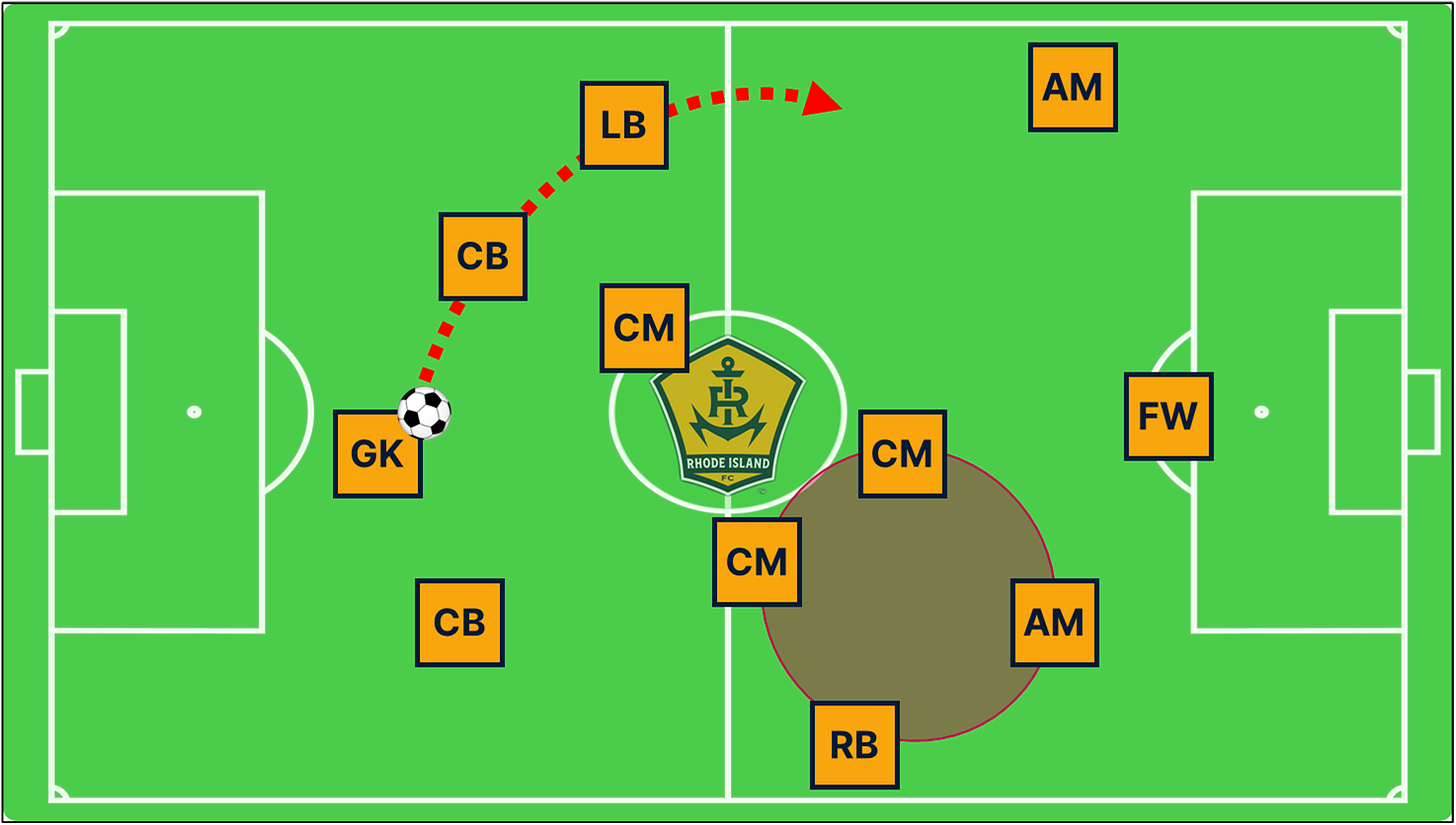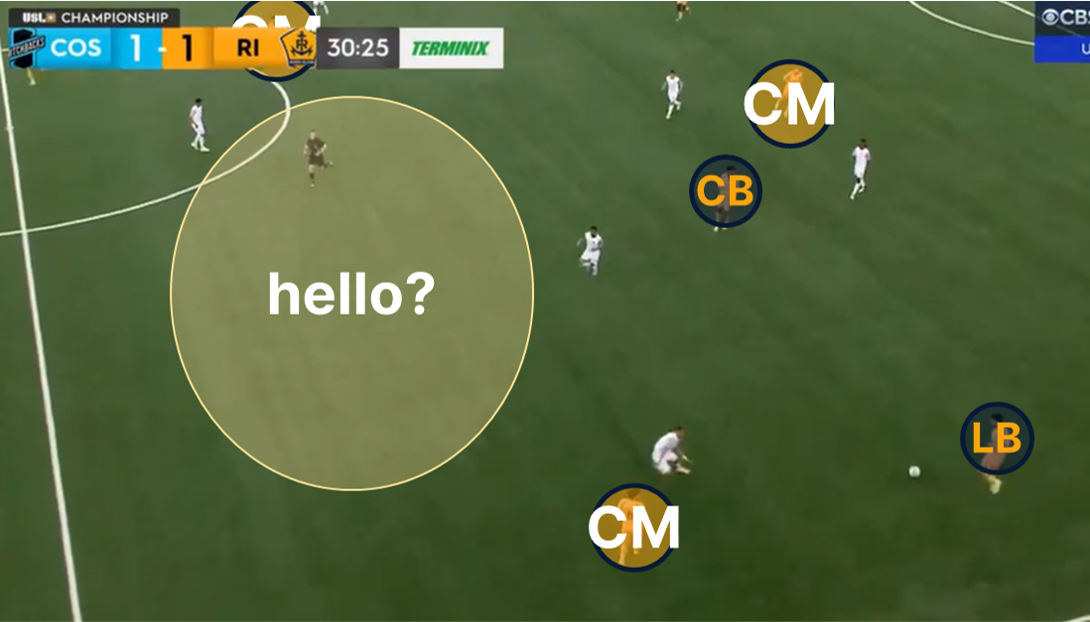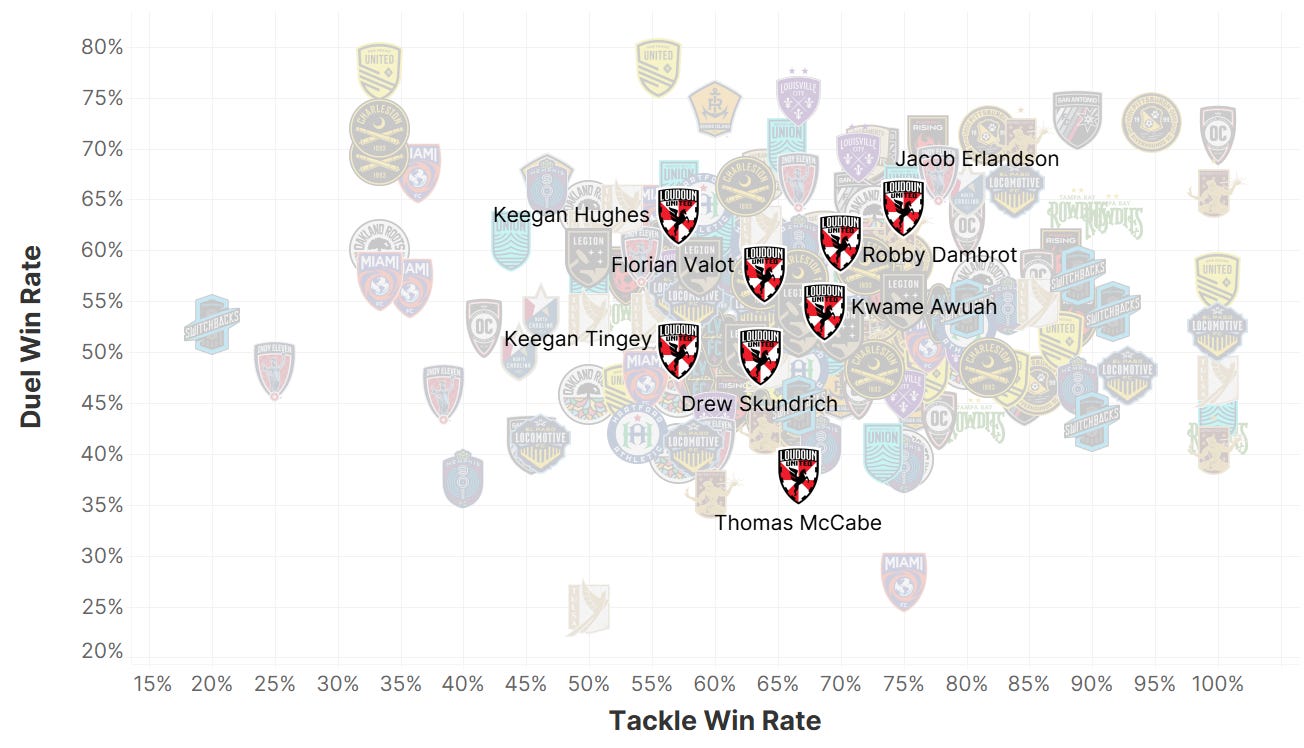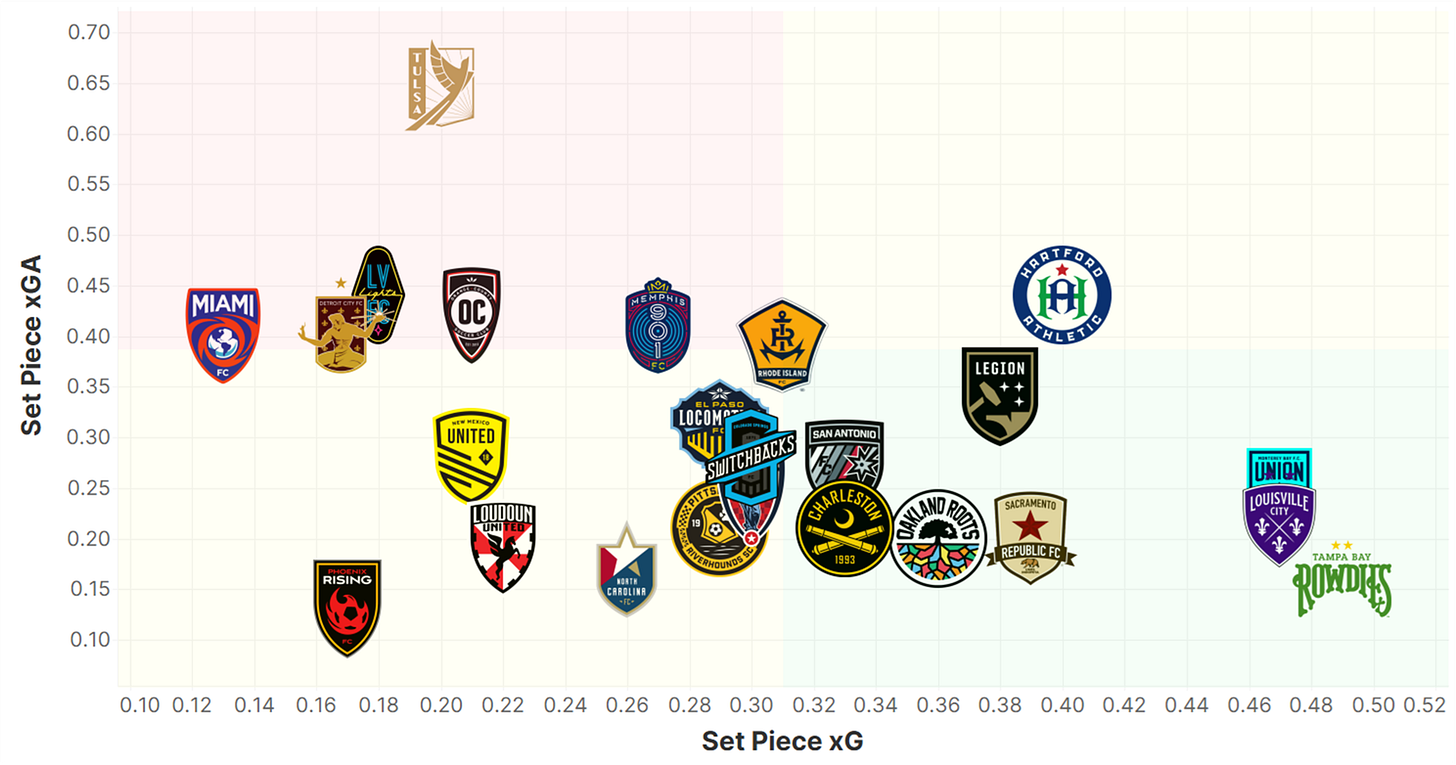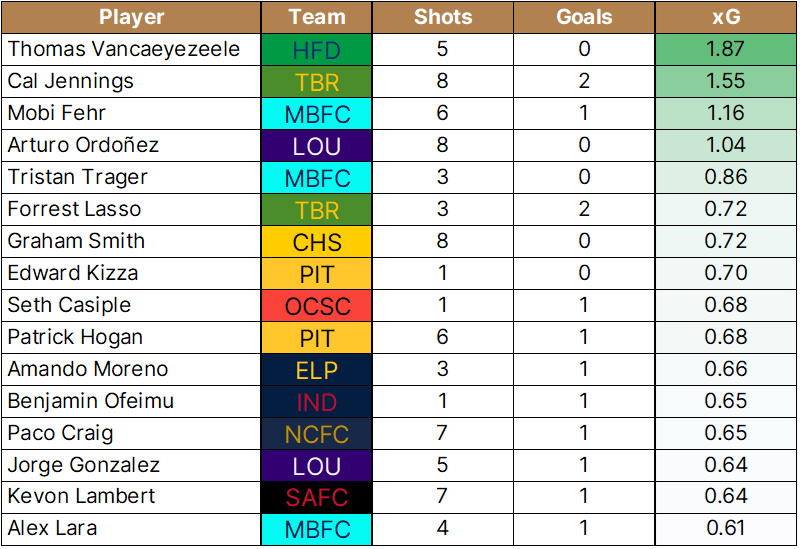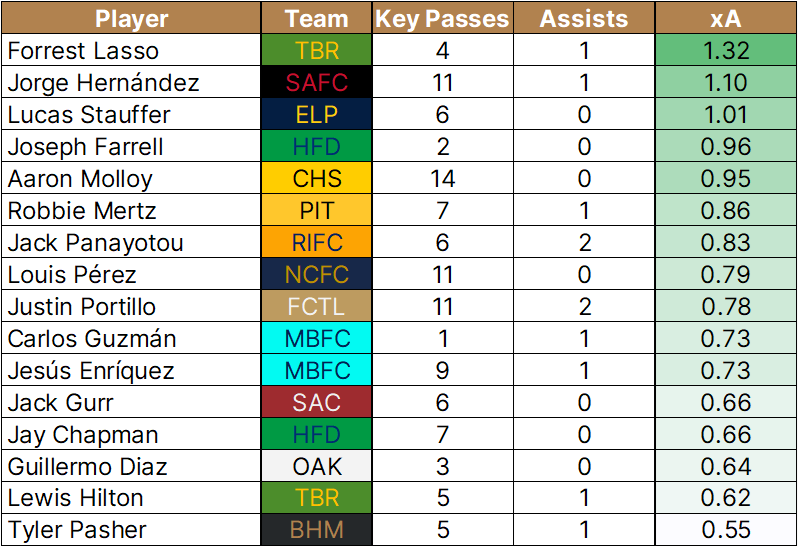The Back Four: Eastern bubble and set pieces
Tactics, stats, and other developments that defined the week for Rhode Island, Loudoun, and Hartford
Welcome to The Back Four, where I’m analyzing four things that drew my eye from across the USL. Need an analysis-heavy recap of the entire Championship? Backheeled is the place to be. I’m there with a US Open Cup round-up later this week as well.
Now, let’s get to it.
Rhode to Perdition
Two things are true:
Rhode Island FC is a top 10 offense by xG per game.
Rhode Island FC has the fourth-worst actual goalscoring record in the league:
What’s the disconnect? Albert Dikwa has three goals on 96th percentile expected scoring, and he’s getting an above-average share of touches at his position. Players like Stephen Turnbull and Noah Fuson have been breakout stars. And yet, this team can’t score with consistency.
Khano Smith started the year in a 3-4-1-2, a shape underpinned by a fairly high back line and an aggressive pressing mentality. RIFC wanted to go relatively direct from the back and pin their opponents, and they were fairly successful in doing so.
Since then, the team shifted into a slightly off-balance 4-2-3-1, and the returns have still been strong on paper.
A few patterns have prevailed within the new shape. Turnbull tends quite high on the right side, while left back Gabriel Alves - always a favorite of mine for his control in possession - sits lower to help initiate. With Koke Vegas returned to the starting lineup, there have been moments of a quasi 4-3-4 depending on the dynamic out wide.
Prince Saydee finally got starting minutes on the left wing in tandem with the shape change. Last year, the wide forward broke out with Hartford Athletic, nabbing 10 goals and three assists as a counterattacking maestro in an otherwise feckless side. The hope was that Saydee could apply his speed and one-on-one capabilities into a considerate RIFC style, but it hasn’t quite come off.
By contrast, Fuson has been utterly undroppable on the right in both defensive and offense senses. Amongst all attackers, the former Columbus Crew 2 man ranks in the 77th percentile for expected assists, the 69th for expected goals, and roughly at par by every defensive metric. That latter point diesnr even do justice to his spirited effort in the press.
Rhode Island’s best defensive sequences come in the high press, when they create three-man traps at the sidelines. Often, it’s Turnbull, the right winger (typically Fuson), and at least one center mid doing the job. Their defensive rotations are always clean in these scenarios, and the outcomes is a forced turnover more often than not.
You see such a sequence play out above, albeit with Fuson at striker and the sparingly used Mark Doyle on the wing. To start, the striker stops an initial foray into the left channel, driving the North Carolina move rightwards.
Note how Rhode Island responds from there. Doyle stays home, hedging between a wing back and central defender. Marc Ybarra closes hard against a center mid, and he’s supported by Jojea Kwizera’s back rotation. North Carolina has a passing angle, but it’s shut down by a perfectly timed step by Clay Holstad from the No. 6 spot (forget the fact that I accidentally labeled him as a full back in the clip, please).
None of the closedowns are initiated without support; there’s a real sense of team identity and communication. The same can’t be said in attack.
Take this isolated moment from last Friday’s loss against the Switchbacks, a game in which RIFC mustered just 1.05 xG, well under their season average. The ball is at Alves’ feet at left back, with the side ensconced in a 4-1-2-3 in build.
You’ll note a few things. Frank Nodarse, the center back who hit Alves with the pass, is a bit high upfield, requiring Holstad to drop and become Rhode Island’s deepest outfield player. Meanwhile, left-of-center attacking midfielder Jack Panayotou has come low on the sideline to provide an immediately outlet for Alves.
What you aren’t seeing is a single run into the center of the park to give Alves a progressive passing option. The former Marshall and Birmingham Legion man is more than capable of find a runner in that open pocket, yet one never comes.
Rhode Island’s attacking midfielders attempted 21 passes in zone 14 during the loss in Colorado Springs. Of those passes, 18 were sideways or backwards, and only three were aimed into the penalty area itself. It’s emblematic of an stunted ability to work into dangerous areas with control.
I’m curious how a healthy JJ Williams helps the cause. As good a scorer as he is, Williams is equally adept at sitting underneath a fellow striker and either winning headers on or ruthlessly shouldering off defenders in hold-up. A 4-2-3-1 with him as a pseudo No. 10 could work nicely.
No matter how Williams figures in, as a starter or otherwise, something needs to change.
Loudoun’s tinkering
Is Loudoun good? It’s a question I’ve debated mentally more than a few times. This season, more than any other, Ryan Martin’s team seems poised to make a push for the playoffs in avoidance of the usual summer flameout.
The numbers are mixed. Loudoun has the third-worst xG in attack in the USL, and their actual output has hewn close to that mark. The defense ranks 11th in the division, just into the top half, and you figure it would be even better without a few particularly odious goalkeeping mix-ups in the early weeks.
Loudoun’s entirely overhauled back half has been an underrated source of strength in 2024. Jacob Erlandson, a star recruit from Columbus Crew 2, is a rock of a central defender, and former Crew teammate Keegan Hughes forms a natural partnership alongside him. There isn’t a more exciting full back in the league than Kwame Awuah, and he’s been an efficient intervenor to boot.
Structurally, Loudoun have mostly used a 4-4-2 this season. You’ve often seen Awuah granted a bit more freedom than whoever’s playing right back. There’ve been a host of picks on the right amidst injuries, ranging from Drew Skundrich to Keegan Tingey to Yanis Leerman.
That a defense on the borderline of “revolving door” status in terms of personnel has held together is a credit to Tommy McCabe and Florian Valot in the pivot. Neither pops off the stat sheet defensively; McCabe ranks in the 12th percentile for total defensive actions, for instance. Still, the journeyman’s tempo-setting passing and wonderful positioning are calming forces for this side.
Valot comes off better by the holistic numbers. He’s in the 95th percentile for touches amongst center mids and ranks in the top quarter at his position for expected assists. He’s a freer mover than McCabe, one more likely to press high and go for a challenge while his partner sits deep to preserve structure.
Those same principles of give and take in the central midfield apply when Loudoun builds out. Above, you see an example of a typical sequence. Going step by step:
McCabe - who often properly drops between the central defenders to forge a back three by proxy - gets a low touch.
He plays into a narrow winger. Loudoun loves to keep both wide midfielder in their 4-4-2 within the hashmarks.
As the ball moves forward, Valot steps into the hole and both full backs start to push higher.
The play fizzles out, and Loudoun ultimately repeats the same sequence down the left side after resetting. There’s nothing inherently off with this play, but it represents how there’s a bit of stasis in the basic system. Blame underwhelming wingers or somewhat uninvolved forwards, but there have been too many moments where good build-outs go mum.
On Saturday night, Ryan Martin turned to a back three system that seemingly solved a lot of those issues.
No need to drop McCabe low, for one: you’ve already got an extra man at the back to allow for more width. In the example, Matai Akinmboni can space to the left as an outside defender, and he find a passing angle as a result. There’s a real sense of flow from there.
One forward drops in to receive from Akinmboni, and he deftly lays off the pass. Meanwhile, Loudoun still keeps two forwards upfield as outlets, and Tingey can soar up the right with less defensive responsibility than he’d have as a more conservative full back. It may seem counterintuitive, but adding an extra center back made the offense flow with additional grace.
Sidebar: Kwame Awuah
Not to re-create that one graphic about Thaddeus Young, but if you want a USL full back that’s (1) completing as many passes, (2) earning as many expected assists, (3) winning tackles at as an efficient a rate as Kwame Awuah, you’ve only got two other options. There’s nary a defender in the league who is re-creating what the Canadian is doing at left back in Virginia.
Awuah is a top 15 crosser by volume so far this season across all USL players, and his accuracy is in line with normal standards. Still, it’s the acceleration in tight spaces and eye for end-to-end recoveries that make the defender so potent. That sort of effort is impossible to quantify, but it’s the stuff that makes the 28-year-old so crucial.
Teams for which Kwame Awuah suits up tend to be elite, and that’s not by accident. He won back-to-back titles in the Canadian Premiership in 2019 and 2020, and he helped lead St. Louis City 2 to a top-of-the-East season in 2022. It was devastating for Loudoun that Awuah played just 43 minutes last year amidst injuries, and he’s more than making up for lost time.
The question henceforth is multi-faceted. Does Loudoun stick with a back three? How long does Akinmboni stay, and will the system work without him? Is Kalil ElMedkhar ever getting a start?
Ultimately, there’s room to experiment. Loudoun has suffered more injuries than your average club and integrated more new faces all the while, yet they’re still in the playoff mix. Maybe Akinmboni goes; maybe ElMedkhar is the league’s best super sub. As long as the defense keeps performing at a high enough level, Ryan Martin can keep tinkering until he finds what works, back three or otherwise.
Hartford apathetic
Five short weeks ago, Hartford sat on 92% playoff odds by my modeling. It seemed like the Brendan Burke revolution would go off without a hitch, seeing a long-beleaguered club into contention. Fast forward through a winless run featuring shape changes, stylistic edits, and numerous lineup permutations, and Hartford’s at a coin flip for playoff qualification.
The attacking joy initially found through a rapid-fire, wing-centric attack is nowhere to be found. Deshane Beckford and Romario Williams haven’t scored since April 6th during a hard-fought win against Miami that should’ve been a red flag in hindsight. Michee Ngalina got a consolation tally against Indy on Saturday, but his last goal before that came in March. The stars aren’t shining in Connecticut.
Still, it’s the defense that’s the real worry. In their last five matches, Hartford have conceded an average of 2.6 xG, which is…like…mind-bogglingly bad. Their best performance came in a 1-0 loss to Charleston where Burke and co. only gave up 1.4 xG, but they only did so by sitting in the most negative back five you can imagine.
That same 5-2-3 recurred in the ensuing loss against Colorado Springs and is seen above. Somewhat brighter and more aggressive in the press, the shape was no more successful; Hartford conceded upwards of two expected goals in a 2-0 loss.
In the example, all three forwards push up against the Switchbacks’ wide-split center back pair, and so does midfielder Jay Chapman. However, Ngalina’s outside-in closing angle and Chapman’s central presence aren’t in sync, and the Switchbacks can play through easily.
The remaining mid, Marlon Hairston, is isolated and can’t stop the line-breaking pass. Suddenly, the Switchbacks have four attackers going against four defenders, with Hairston and wing back Tristan Hodge failing to get goalside of the ball. The ensuing assist from Maalique Foster and finish from Yosuke Hanya are ridiculously good, but the defending is poor.
Thus, it was back to a 4-2-3-1 against Indy on Saturday night. The results were no better, and Hartford went down a goal within four minutes on a lazily conceded penalty kick. Above, you’re seeing the third of four concessions, one that encapsulates more of this club’s problem.
You once against start with misaligned pressure, marked by a failure of any attacker to make a proper recovery into position on the right flank. Hartford went with a bulkier central midfield featuring three true box-to-box types in the midfield, but the fact that none get to the Indy carrier in acres of space is concerning nonetheless.
What’s more concerning still is the knock-on effect downfield. Because one link in the chain fails, there’s essentially a four-on-three overload down the right. Hairston must hedge between the carrier and an Indy center mid in the channel; Rece Buckmaster and Jordan Scarlett are stuck in one-on-ones in defense.
You know the rest of the story. Buckmaster and Scarlett are a step slow on the backtrack and fail to rotate with any level of cohesion, and it’s a goal for the Eleven.
More than anything else, Hartford has been burned by extremely poor execution of a genuinely logical gameplan. It’s not like Brendan Burke has strayed far from his baseline principles, outside of that spell in a back five. His team was playing vintage Burke-ball in Indianapolis, and the players weren’t up to the challenge.
If anything, Burke the coach is being undercut by Burke the general manager at the moment. Hartford struggled in 2023 by relying on past-their-prime veterans to get the job done. Right now, they have the exact same problem in defense, and it’s leading to disastrous results.
Set piece check-in
Who are the best teams in the USL when it comes to dead-ball situations? Corner kicks and free kicks are hugely important factors in the game, and I’m very guilty of not giving them enough attention. The numbers can help illustrate who’s doing the most to get and/or stop chances on set pieces.
Louisville and Tampa Bay being the best two teams in the league on set pieces is probably the least surprising stat in the universe. Forrest Lasso just got a brace off dead balls this past weekend, and Louisville is spoilt for choice between their aerial threats (Ordonez, Totsch, Harris) and their skillful takers.
What might be less obvious is the presence of Monterey. They’ve succeeded by committee off of corner kicks especially. Alex Lara, Mobi Fehr, Tristan Trager, and Carlos Guzman have all done damage getting into the box and finding opportunities.
In defensive situations, Phoenix Rising is unmatched. Interestingly, Rocco Rios Novo is 17th in the league in catches and 22nd in punches, but the defensive solidity remains. Thank Pape Mar Boye (25 for 46 on aerial duels), John Stenberg (12 for 19 in less times), and good coaching and scouting for the edge.
On the flip side…what’s up with FC Tulsa? Dividing time in net between Michael Creek and Joey Roggeveen probably hasn’t helped, and the team is a cumulative 46.7% on all aerial duels, but almost 0.65 set piece xG conceded per match is wild.
Here’s the leaderboard for player-by-player xG off of corners…
…and the flip side for xA. Forrest Lasso appearing on both lists is fun, evidencing his ability to get his head on everything. In terms of actual takers, it’s names like Jorge Hernandez and Aaron Molloy that stand out on volume. Jack Panayotou is a fun case, having picked up two corner kick assists in two USL starts.
Jack Blake is the current free kick king, having earned 0.5 xG on six shots. Hernandez (0.4 xG on five shots) and Adrien Perez (0.4 xG on four shots) aren’t far behind.
Threads!
I post too much, so here’s a backlog of my bigger game recaps. Looking for Oakland talk? Check out this week’s USL Tactics Show.
Final Thoughts
I usually do this chunk right before I hit “publish,” but I’m literally on jury duty right now, so…uh…maybe next week. Go read Nicholas Murray and subscribe to The Rondo or something.
See you soon!


